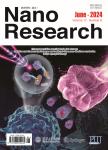Formation mechanism of twin domain boundary in 2D materials: The case for WTe2
作者机构:Key Laboratory of Artificial Structures and Quantum Control (Ministry of Education) School of Physics and Astronomy Shanghai Jiao Tong University Shanghai 200240 China Department of Physics Applied Physics and Astronomy Rensselaer Polytechnic Institute Troy New York 12180 USA Institute of Chemical Materials China Academy of Engineering Physics (CAEP) P. O. Box 919-327 Mianyang 621900 China International Center for Quantum Materials School of Physics Peking University Beijing 100084 China Department of Physics Massachusetts Institute of Technology Cambridge MA 02139 USA Tsung-Dao Lee Institute Shanghai 200240 China
出 版 物:《Nano Research》 (纳米研究(英文版))
年 卷 期:2019年第12卷第3期
页 面:569-573页
核心收录:
学科分类:0808[工学-电气工程] 0809[工学-电子科学与技术(可授工学、理学学位)] 07[理学] 0805[工学-材料科学与工程(可授工学、理学学位)] 0702[理学-物理学]
基 金:We thank the Ministry of Science and Technology of China (Nos. 2016YFA0301003 and 2016YFA0300403) the National Natural Science Foundation of China (Nos. 11521404, 11634009, U1632102, 11504230, 11674222, 11574202, 11674226, 11574201, 11655002, and U1632272) for partial support W Y. X. was supported by the National Science Foundation Award (No. DMR-1305293) S. B.乙 was supported by the US Department of Energy (DOE)(No. DESC0002623) The supercomputer time sponsored by National Energy aesearch Scientific Computing Center (NERSC) under DOE contract (No. DE-AC02-05CH11231) the Center for Computational Innovations (CCI) at Rensselaer Polytechnic Institute (RPI) are also acknowledged This project has been supported by a grant &om Science and Technology Commission of Shanghai Municipality (No. 16DZ2260200) and the Strategic Priority Research Program of Chinese Academy of Sciences (No. XDB28000000)
主 题:twin domain boundary seanning tunneling microscopy (STM) density functional theory strain WTe2
摘 要:Our scanning tunneling microscopy (STM) study observes, for the first time, twin domain boundary (TDB) formations on the surface of WTe2 single crystal, which is glued by solidifying indium to Si substrate. In these TDB regions, a large inhomogeneous strain field, especially a critical shear strain of about 7%, is observed by geometric phase analysis. This observation does not obey the old believe that a small mechanical stress is sufficient to drive thermally-induced TDB formations in two-dimensional materials. To resolve the contradiction, we perform density functional theory calculations combined with elasticity theory analysis, which show that TDBs on WTe2 are entirely displacement-induced, for which a critical strain is necessary to overcome the onset barrier.



